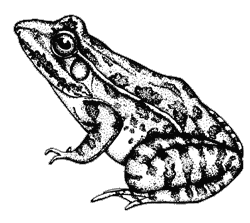Leopard Frog
(Rana spp.)
Order: Salientia
Family: Ranidae (true frogs)
Spanish name: rana
Distinguishing Features
At least 9 species of leopard frogs and several close relatives are found in the Sonoran Desert region. Differences among species are small and often indistinguishable to the human eye. All species are fairly large with pointed snouts, webbed hind toes, long, powerful hind limbs, and large external eardrums. Colors vary from tan to green or brown with irregular patterns composed of spots, bars, and blotches of darker green, brown or black.

Range
These frogs occur from coast to coast and from Canada through Mexico. They are found throughout the Sonoran Desert along permanent and intermittent streams from near sea level to 7900 feet (2410 m).
Habitat
These frogs inhabit permanent and intermittent streams, irrigation canals, and some ponds.
Life History
Leopard frogs are insectivorous and piscivorous (fish-eating). Highly aquatic, they often jump into water from the streambank to avoid capture. Leopard frogs may breed year-round, and tadpoles may take more than a year to metamorphose. Tadpoles get very large.
Vanishing Frogs
There appears to be a world-wide decline in amphibian populations. In our region, leopard frogs are much scarcer than in years past. A close relative, the Tarahumara frog (Rana tarahumarae), has disappeared from Arizona, the only place in the United States where it occurred. No one knows for sure why amphibian numbers are decreasing, but surely there is more than one cause. Water pollution, acid rain, ozone depletion and excessive ultraviolet radiation, habitat destruction, and introduced species (such a bullfrogs in Arizona) are being examined as potential causes for the crisis. Unfortunately natural populations of amphibians have not been subjects of intensive, long-term study. We therefore rarely know about normal population fluctuations and cannot easily determine if what we are seeing today is an overall trend or just a temporary aberration.










